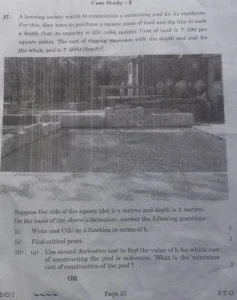Q 2:- A housing society wants to commission a swimming pool for its residents. For this, they have to purchase a square piece of land and dig this to such a depth that its capacity is 250 cubic metres. Cost of land is Rs 500 per square metre. The cost of digging increases with the depth and cost for the whole pool is Rs 4000 (depth)². [CBSE 2023]

Suppose the side of the square plot is x metres and depth is h metres.
On the basis of the above information, answer the following questions :
(i) Write cost C(h) as a function in terms of h. (1)
(ii) Find critical point. (1)
(iii) (a) Use second derivative test to find the value of h for which cost of construction of the pool is minimum. What is the minimum cost of construction of the pool ? (2)
OR
(iii)(b) Use first derivative test to find the depth of the pool so that cost of construction is minimum. Also, find relation between x and h for minimum cost. (2)
Solution:- Given that length of the square piece = x m
depth of the pool = h m
Volume of the pool = l×b×h
x×x×h = 250
⇒ x²h = 250
⇒ x² = 250/h
(i) Cost of the pool with land = 500(x)² + 4000 (depth)²
Since, x² = 250/h
C(h) = 500×250/h + 4000 h²
⇒ C(h) = 125000/h + 4000 h²
Thus,cost C(h) as a function in terms of ![]()
(ii) Since, C(h) = 125000/h + 4000 h² . . . (i)
Differentiate with respect to h
![]()
⇒ ![]()
⇒ ![]()
⇒ ![]() . . .(ii)
. . .(ii)
For maximum and minimum ![]()
![]()
⇒![]()
⇒![]()
⇒ ![]()
⇒ ![]() m
m
Hence, the critical point is h = 2.5 m
(iii) From the equation (ii)
![]()
Again differentiate with respect to x
![]()
⇒ ![]()
at h = 5/2 = 2.5
⇒ ![]()
⇒ ![]()
Thus, The cost of the pool is minimum when h = 5/2 = 2.5
From equation (i)
C(h) = 125000/h + 4000 h²
h = 2.5
C(2.5) = 125000/2.5 + 4000(2.5)²
⇒ C(2.5) = 50,000 + 25000 = Rs 75000
Thus, The minimum cost of making pool = Rs 75,000
Q 1:- In a group activity class, there are 10 students whose ages are 16, 17, 15, 14, 19, 17, 16, 19, 16 and 15 years. One student is selected at random such that each has equal chance of being choosen and age of the student is recorded. [CBSE 2023]
On the basis of the above information, answer the following question :
(i) Find the probability that the age of the selected student is a composite number. (1)
(ii) Let X be the age of the selected student. What can be the value of X ? (1)
(iii) (a) Find the probability distribution of random variable X and hence find the mean age. (2)
OR
(iii) (b) A student was selected at random and his age was to be greater than 15 years. Find the probability that his age is a prime number. (2)
Solution:- See full solution
